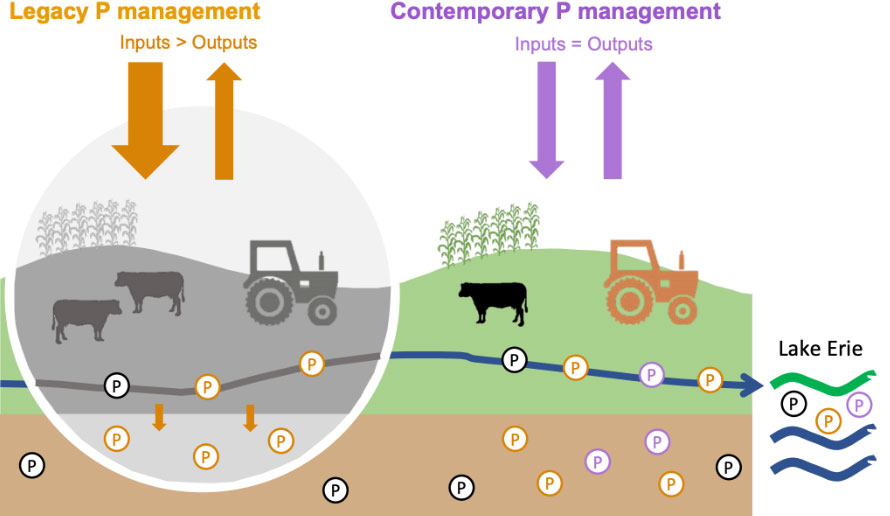Legacy phosphorus remains in the environment well after it is introduced as fertilizer. The USDA defines legacy phosphorus as “phosphorus that contributes to accelerated eutrophication of water bodies as a result of past human activity,” including phosphorus accumulated in soils from past fertilization, phosphorus residing in sediments, and phosphorus in groundwater.¹ ² Other definitions focus solely on phosphorus from fertilizer in cultivated soils.3 4

Source: USDA Legacy Phosphorus project
The amount of phosphorus stored in soil is estimated to be five times greater than the phosphorus we can mine and could help reduce the need for new fertilizers! 5
Origin of Legacy Phosphorus
- Most legacy phosphorus comes from past fertilizer applications that exceeded what the crops needed. When phosphorus is applied as fertilizer, only 10-30% is taken up by crops in the first year.4 The rest, over 70%, is either lost to the environment or builds up in the soil.5
- This buildup happens faster than crops can use it, leading to high soil phosphorus levels for years, even without new fertilizer. In addition, legacy phosphorus is lost for productive use in areas like gullies, tile lines, and soil pores.6
Legacy Phosphorus in the Landscape
- Legacy phosphorus in soil isn't always easy for crops to use. When fertilizer is applied, phosphorus starts off in a form that plants can easily take up. However, it quickly becomes locked onto soil particles or gets mixed into organic matter.
- In acidic soils (pH < 7), phosphorus binds with iron and aluminum. In alkaline soils (pH > 7), it binds with calcium. This phosphorus becomes available to plants only after it breaks down through natural processes.³
Excess phosphorus can wash into waterways, leading to legacy phosphorus in rivers and lakes, which can mask or diminish the benefits of on-farm conservation efforts. Even without additional fertilizer applications, legacy phosphorus can impact runoff for decades unless proper management practices are implemented.6
Resources:
1 Muddied Waters: The Use of “Residual” and “Legacy” Phosphorus
2 Terminology for Residual and Legacy Phosphorus
4 Accessing Legacy Phosphorus in Soils
5 Lake Erie, phosphorus, and microcystin: Is it really the farmer’s fault?